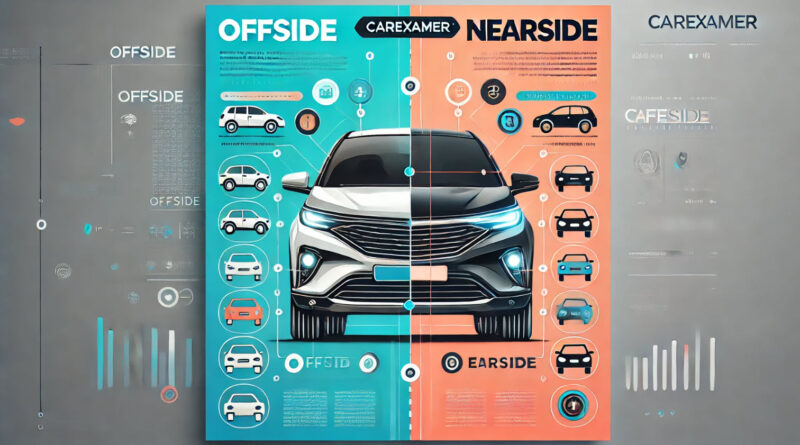Nearside and Offside on a Car – What Do They Mean?
Let’s break it down and explain what nearside and offside are, why they matter, and how knowing the difference can help you maintain your car. Ever been to the mechanic or read your car’s MOT report and wondered what on earth “nearside” and “offside” mean? You’re not alone! These terms can be confusing if you’re not familiar with them. But don’t worry—once you get the hang of it, it’s pretty simple.
What Is the Nearside on a Car?
The nearside of your car is the side closest to the curb when you’re driving. In countries like the UK, where you drive on the left side of the road, the nearside refers to the passenger side. So, think of it as the side closest to the pavement when you park.
- Nearside = Passenger Side (in countries like the UK)
What Is the Offside on a Car?
The offside is the opposite of the nearside—it’s the side furthest from the curb. In countries where you drive on the left, like the UK, this means the driver’s side of the car. So, when you park, it’s the side closest to the road or traffic.
- Offside = Driver’s Side (in countries like the UK)
Why Should You Care About Nearside and Offside?
Understanding nearside and offside isn’t just about knowing your car terminology. It’s super helpful when it comes to things like maintenance, repairs, and safety. Here’s why:
1. MOT Reports and Servicing
When your car goes in for its MOT or a service, you’ll often see mechanics refer to the nearside and offside. For example, if your report says the “nearside rear tire is worn,” you’ll know it’s talking about the rear tire on the passenger side.
2. Buying Parts
If you’re ordering parts like mirrors, lights, or tires, knowing the difference between nearside and offside can save you from buying the wrong thing. For example, if you need an “offside mirror,” it means you’re looking for the driver’s side mirror.
3. Safety Checks
Doing regular safety checks on your car is crucial. Knowing the terms makes it easier to understand and communicate which side of your car you’re inspecting, whether it’s the tires, lights, or mirrors.
Nearside and Offside Around the World
In countries where you drive on the right-hand side of the road—like the US or most of Europe—the meanings of nearside and offside are flipped.
- Nearside = Driver’s Side (because it’s closest to the curb)
- Offside = Passenger Side (because it’s furthest from the curb)
How You’ll Hear These Terms Used
Let’s look at a few common scenarios where you’ll hear mechanics or MOT testers use these terms:
1. Tires
- “You need to replace your nearside rear tire” means the rear tire on the passenger side.
- “Your offside front tire is worn” means the front tire on the driver’s side.
2. Mirrors
- A broken nearside mirror means the passenger-side mirror is damaged.
- If your offside mirror is cracked, it’s the driver’s side one.
3. Lights
- “Your nearside headlight is out” means the passenger-side headlight needs replacing.
- “The offside rear light is faulty” means the rear light on the driver’s side is the issue.
Other Terms You Might Hear
Along with nearside and offside, there are a few other terms you’ll come across when dealing with car maintenance:
1. Nearside Front/Rear
This simply refers to the front or rear part of the passenger side of your vehicle. For example, “nearside front” means the front of the passenger side, and “nearside rear” means the back of the passenger side.
2. Offside Front/Rear
Just like nearside, “offside front” means the front part of the driver’s side, and “offside rear” means the back of the driver’s side.
3. Nearside/Offside Wing
A car’s wing is the panel on the side of the car, so the nearside wing refers to the passenger side panel, while the offside wing is the driver’s side panel.
Wrapping It Up
So, to keep things simple:
- Nearside is the passenger side of your car in countries like the UK (closest to the curb).
- Offside is the driver’s side (furthest from the curb).
Knowing these terms is handy when it comes to understanding your MOT report, buying parts, or doing regular maintenance checks. It’ll make your life easier, save you time at the mechanic, and help you avoid mistakes when ordering car parts. Whether it’s a worn tire or a broken mirror, now you’ll know exactly which side of the car it’s on!
Buying a used VW. Buying used vauxhall, BMW, Jaguar, Ford, Volvo, Range rover, Bentley, Aston Martin, Porsche, Ferrari, Lamborghini, Maserati, Hyundai, Tesla, Honda, Pagani

